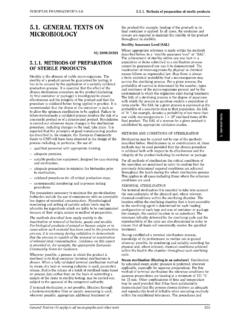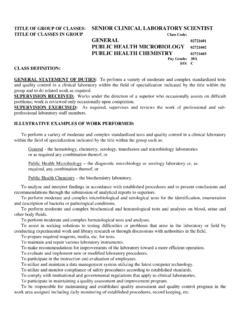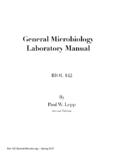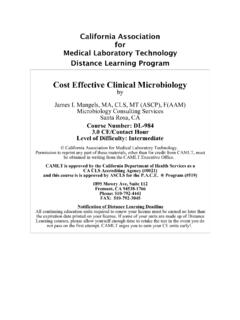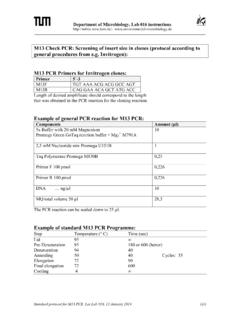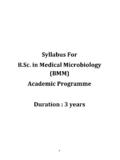Transcription of Module 1: Introduction to Microbiology & …
1 Module 1: Introduction to Module 1: Introduction to Microbiology & MicroorganismMicrobiology & MicroorganismLearning Objective:Knows the basic knowledge of the theories of spontaneous generation among the major group of organism of studiedin several ways in which microbes affect our Microbes in our livesLiving things too small too be seen with theunaided eye are called is important in the maintenanceof an ecological balance on and are needed to maintain the animal microorganisms are used to produce foodsand microorganism cause The First ObservationRobert Hooke observed the plant material was composedof little boxes.
2 He introduced the sobservationswerethegroundworkforHooke sobservationswerethegroundworkfordevelop ment of the cell theory, the concept that all livingthings are composed of Van Leeuwenhoek, using a simple microscope, wasthe first to observe Hypothesis of the Origin of the MicroorganismTwo hypothesis attempted to explain the origin of the microbes: Biogenesis They arose only from other living things of their samekind. Theory of Spontaneous Generation They arose spontaneously fromsomething non Until the mid 1880s, many people believed in spontaneousgeneration, the idea that living organisms could arise fromnonlivingmatter.
3 Francesco Redi demonstrated that maggots appear on decaying meatonly when flies are able to lay eggs on the meat. Louis Pasteur demonstrated that microorganisms are in the aireverywhere and offered proof of biogenesis by using variousshapes ofswan necked The Diversity of Bacteria Bacteria are unicellular organisms. Because they have nonucleus, the cells are describes as prokaryotic. The three major basic shapes of bacteria are bacillus, ( ). ( ). Most bacteria have a peptidoglycan cell wall; they divideby binary fission; and they may possess flagella.
4 Bacteria can use a wide range of chemical substances fortheir Fungi Fungi(mushroom,moldsandyeast)haveeukaryo tic cells (with true nucleus). Most fungiare multi cellular. Fungi obtain nutrients by absorbing organicmaterial from their Protozoa Protozoa are unicellular eukaryotes and classifiedaccording to their means of locomotion. Protozoa obtain nourishment by absorption oringestion through specialized Algae Algae are unicellular or multi cellular eukaryotesthat obtain nourishment by photosynthesis. Algae produce oxygen and carbohydrates that areused by other Viruses Viruses are non-cellular entities that are parasitesof cells.
5 Viruses consist of a nucleic acid core surroundedby a protein coat. An envelope may surround The Impact of microorganism on Human Microorganisms as a decomposer Microorganisms degrade dead plants and animals and recyclechemical elements to be used by living plants and animals. For examples, bacteria are use to decompose organic matter insewage and microbes decompose food into simple Microorganisms as a nitrogen fixer Some bacteria live in nodules on a plant roots. Atmospheric nitrogen compounds that the plants can use NH3 Nitrogen fixer bacteria Microorganisms and the food industry Dairy Product(cheese, yogurt, yogurt drinks, chocolate) Baked goods Alcoholicbeverages Alcoholicbeverages Tempeh (Indonesian traditional food) Pickles VinegarModule 2: Module 2: Methods for Studying MicroorganismMethods for Studying MicroorganismLearning Objective:Learning Objective:After reading this Module , students should be able to.
6 Define total magnification & a use for dark field, phase-contrast, DIC, and florescencemicroscopy and compare each with bright field the step in preparing a Gram stain, and describe the appearance ofgram positive and gram negative cells after each MicroscopeMicroscope is an instrument that magnifies the size of imageof an object to be seen with thenaked two key characteristics of a reliable microscope are;i. Magnification- the ability to enlarge image of an object. A compound light microscope uses multiple lensesto refract light to achieve total magnification is the product of the magnifying powers of the individual lenses where:Power of objective x Power of ocular = Total Magnification 4x X 10x = 40x10x X 10x = 100x30x X 10x = 300x100x X 10x = 1000xii.
7 Resolution/ Resolving Power (R)- the resolving power (R) of an microscope is the closest spacing between 2 point at whichthe point can still be seen clearly as separate the resolving power of a light microscope depends on the wavelength of light ( ) and aproperty of the objective lens, called the numerical aperture (NA)R = /NAFrom it image, when light is transmitted through specimen, being denser and more opaque then itssurrounding absorbs some of this light, and the rest of the light a result, the specimen will produce an image that is denserthen surrounding brightly illuminated field.
8 Can be used for both live, unstained material and preserved,stained Dark field Dark field MicroscopeUsed for examining live microorganisms that either are invisible inthe ordinary light a dark field condenser that contains an opaque disk. The diskblocks light that would enter the objective directly. Only light that isreflectedoff(turnedbackfrom)thespecime nenterstheobjectivereflectedoff(turnedba ckfrom)thespecimenenterstheobjectivelens . Because there is no direct background light, the specimenappear light against a black used to examine unstained microorganisms suspended microbe -Treponema Phase Contrast Phase Contrast MicroscopeIt permits detailed examination of internal structure inliving organism.
9 Not attach the microbes to themicroscope the light source through the specimen, their velocitymay be altered by differences in the thickness andphysical properties of various portion of the rays passing through the specimen are diffracted(bent) differently and travel different pathway (out ofphase with one another) to reach eye of the of the internal structure of the specimen alsobecomemoresharplydefinedinphase-cont rastmicroscope. The internal detail of a cell appear as degreesof brightness against a dark microscope used the special condenser that containsanannular(ringshaped) ,anannular(ringshaped) ,focusing light on the specimen and a ring shapeddiffraction (phase) plate in the objective diffraction and undiffracted rays are then bought intophase with each other to produce the image that meetsthe Fluorescence Fluorescence MicroscopeTakes advantages of florescence of absorb short wavelength substances absorbshortwavelengthsoflight(v)
10 Shortwavelengthsoflight(v)Give off light at longer wavelength that can be seen bythe use of the special light StainingStaining means coloring a microorganism with a dye to make somestructure more uses air and heat to attach microorganism to a stains, such as the gram stain and acid fast stain, dividebacteria into groups according to their reaction to the gram-stain produce uses the purple stain (crystal violet) iodine as amordant, an alcohol decolorized and the red counter bacteria retain the purple stain after decolorization step:gram negative bacteria do not and thus appear pink from the counter fast bacteria, such as members of the genera Mycobacterium andNocardia, retain carbolfuchin after acid alcohol decolorization and appearred.

